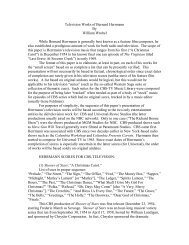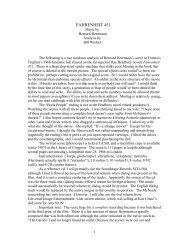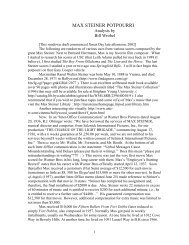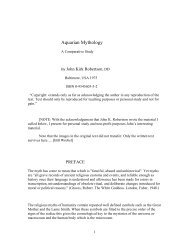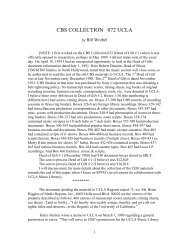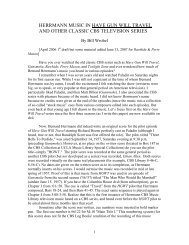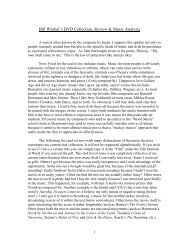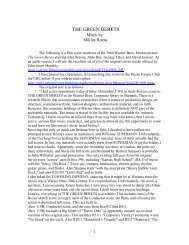Valentine's Day, Sunday, February 14, 2010 at 10:20 am
Valentine's Day, Sunday, February 14, 2010 at 10:20 am
Valentine's Day, Sunday, February 14, 2010 at 10:20 am
- No tags were found...
You also want an ePaper? Increase the reach of your titles
YUMPU automatically turns print PDFs into web optimized ePapers that Google loves.
_______________________________________________talkingherrmann mailing list**********************<strong>10</strong>-29-09:Talking Herrmann: Herrmannesque SteinerNew topic by: Bill Wrobel ()______________________________________________________________________In various other posts (including one recently about Lion & the Horse) I have discussedhow Max Steiner music has a certain affinity to the music of Bernard Herrmann. It's notoften but it shows fairly enough so th<strong>at</strong> I remark to myself, "You know, th<strong>at</strong> sounds reallyHerrmannesque" or ""I bet Herrmann could really rel<strong>at</strong>e to th<strong>at</strong> piece as to similar styleand sensibility."Another ex<strong>am</strong>ple is from one of my favorite Steiner movies, a fun "B" f<strong>am</strong>ily westernfrom 1954 titled The Boy from Oklahoma" starring Will Rogers, Jr. It was recently oneither TCM or the Westerns Channel. Several times in the movie he had a dr<strong>am</strong><strong>at</strong>icst<strong>at</strong>ement motif normally associ<strong>at</strong>ed with the bad guy in the film (Anthony Caruso).In theimage below he has a brief first st<strong>at</strong>ement of it <strong>at</strong> Reel 3/4 in the movie when the old mantells the hero about the mail being stolen in a stagecoach robbery, "No luck connectedwith this son, good or bad." Terrific music employing the rinforzando brass especially buthe effectively mixes the effect with the woodwinds and strings. It ends on a powerfullyheld ferm<strong>at</strong>a deep D maj (D/F#/A) resonance chord. Herrmann would be proud! The firstimage is my own personal research copy. We have Bars 21-25, skipping to the end of thecue with Bars 28-30 of th<strong>at</strong> motif figure I like so much.The second image is towards the very end of the picture when the boy says inexasper<strong>at</strong>ion, "Women!" and then we have the repe<strong>at</strong> villain motif repe<strong>at</strong>ed in spades asCaruso is driven slowly down the street. Except for a few annot<strong>at</strong>ions by me, this imageis a reproduction of the first four bars of Reel <strong>10</strong>/6.I believe the tonalities are E maj(E/G#/B) to C maj (C/E/G) back to E maj to the D tutti tone to (Bar 2) C min (C/Eb/G)and so forth. Steiner seemed to employ more major and Dominant chords in his musicthan Herrmann. Herrmann loved the half-diminished 7th but Steiner did not use themanywhere as much as Herrmann (or even Rozsa) but there is a special cue in The FBIwhere Steiner does a multiple descent of just half-diminished chords. I'll have to find th<strong>at</strong>one in my box somewhere. R<strong>at</strong>her Herrmannesque too.At any r<strong>at</strong>e, these top film music composers had this strong tendency to REPEAT <strong>am</strong>usical structure or thought-form r<strong>at</strong>her frequently so th<strong>at</strong> it really impresses thelistening audience, ingrains or registers a certain mood thru this almost hypnotic deviceof repe<strong>at</strong>ing over & over again (ostin<strong>at</strong>os were a favorite of Herrmann). Of course, thismethod is a time-saver as well, r<strong>at</strong>her like w<strong>at</strong>er flowing along thru a p<strong>at</strong>tern of leastresistance. Just repe<strong>at</strong> some motif or short phrase and then go a half tone or whole tone<strong>14</strong>9




